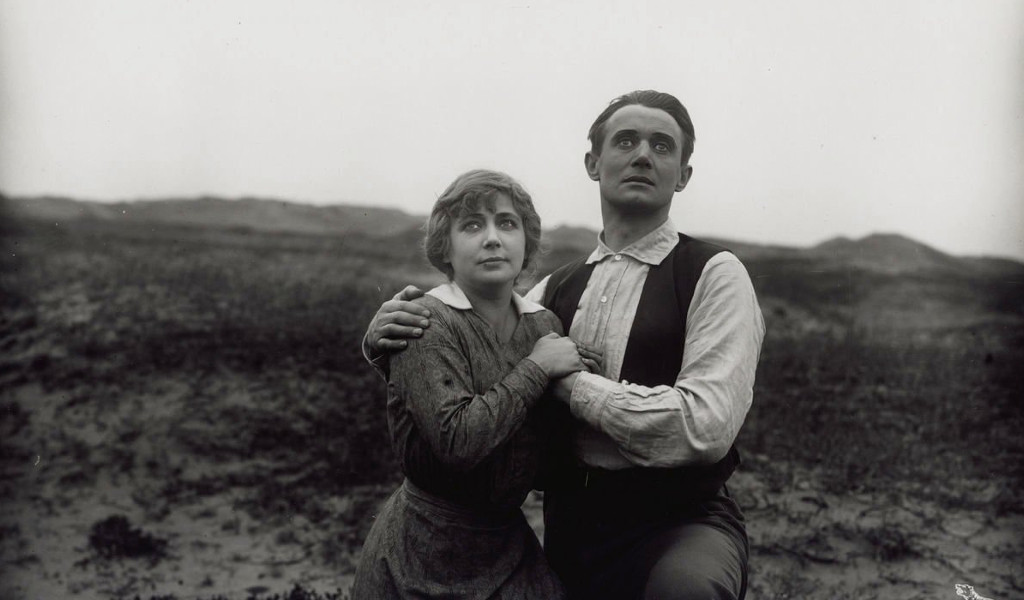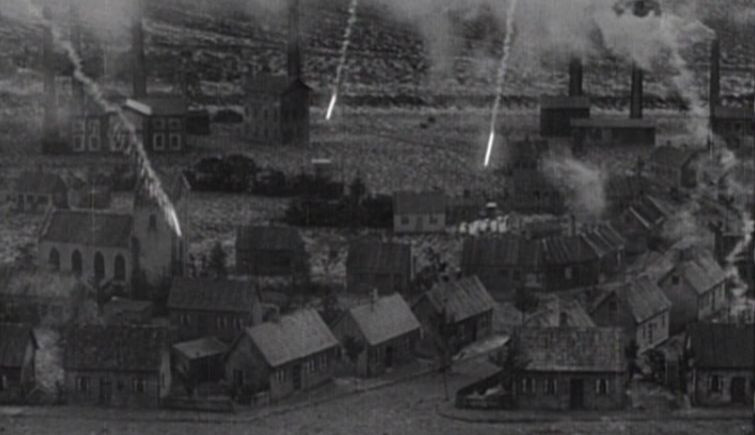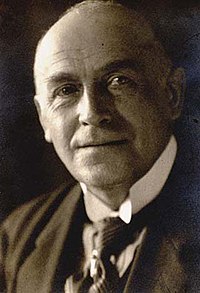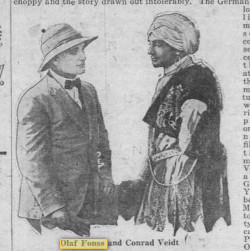∗∗∗∗∗∗∗∗∗∗
(7/10) This Danish moral tale from 1916 is the world’s first apocalyptic film. August Blom’s direction takes takes it sweet time to get going, but when the much talked about comet finally crashes towards the Earth, the film proves why it belongs among the classics. The special effects hold up surprisingly well even today, and the images of post-apocalyptic desolation are haunting.
The End of the World (Verdens Undergang), 1916, Denmark. Directed by August Blom. Written by Otto Rung. Based on the novel La Fin du Monde by Camille Flammarion (uncredited). Starring: Olaf Fønss, Ebba Thomsen, Johanne Fritz-Petersen, Frederik Jacobsen, Carl Lauritzen, Thorleif Lund, Alf Blütecher, K. Zimmermann. Produced by Ole Olsen. IMDb score: 6.5 Tomatometer: N/A Metascore: N/A

Danish director August Blom’s name may not mean much to audiences today. But in the 1910’s Blom was Denmark’s topmost director, head of production at Nordisk Film, and by that token alone one of the most successful directors in the world. According to Collins’ Film Encyclopedia: “Despite the small size of its native market and its relatively limited resources, Denmark reigned supreme for several years (1909-14) as Europe’s most prosperous film center. Its films rivaled those of Hollywood, for popularity on the screens of Paris, London, Berlin and New York.” August Blom’s most famous film is probably the audacious blockbuster Atlantis, released in 1913, depicting the sinking of a great ocean liner, and partly inspired by the sinking of the Titanic the year before. The film cemented Nordisk Film’s resolution in becoming the first major European film company to focus exclusively on full-length feature films.
If Atlantis can be faulted for something, it’s that we never get a shot of the actual sinking of the ship, or even decks filling with water. One moment she is floating perfectly straight while people climb into life boats, in the next shot only the stern protrudes above the water line. Blom did not make the same mistake in The End of the World, depicting a comet brushing the Earth. Here we get superbly exciting scenes of burning meteorites scorching the landscape, houses on fire, explosions and water flooding buildings with people inside. With this film, Blom has captured an apocalyptic event on a truly epic scale, and the films deserves at least as good a reputation as Atlantis. The movie’s reputation has been hampered by the fact that it was unavailable for decades, but in 2006 a beautifully restored version was released by the Danish Film Institute, and thanks to the active film community on the internet, it has quickly found new fans.

But this is no simple crash boom bang film, on the contrary. The director’s trademark was inhabiting his films with a multitude of characters, all involved in intricate plots. This is also true for The End of the World.
The film is a moral tale with crudely drawn stereotypes, and juxtaposes two sisters growing up with their poor mine-working father in a small, unspecified town in an unspecified country in northern Europe. Dina West (Ebba Thomsen) leaves her working class fiancé Flint (Thorleif Lund) almost standing at the altar as she elopes with the young handsome Frank Stoll, the rich owner of the mine (Olaf Fønss), captivated by his promise of a life in luxury. Edith West (Johanne Fritz-Petersen), on the other hand, re-acquaints with an old friend, the sailor Reymers (Alf Blütecher), and the two rekindle their old love.

Three years later we catch up with Dina, now a trophy wife living in luxurious boredom, only alleviated by the pearls and pretty clothes her husband brings home. Frank, on the other hand, has made a killing on the stock market. One day Frank’s cousin, the astronomer Dr. Wissmann (K. Zimmerman) discovers a huge comet will brush past Earth. News of the comet causes great concern among the public, and the stock market plummets. But Frank keeps on buying while others keep on selling, hoping to somehow take advantage of the situation. As the comets approaches, Dr. Wissmann and his colleagues confirm that it will pass close enough to wreak disaster upon Earth. To avoid mass panic, they decide to keep the finding a secret. However, Wissmann agrees to tell Frank. But Frank instead bribes a reporter to put out a fake story that the comet poses no threat. Reassured, the stock market recovers, making Frank insanely rich.

The comet nevertheless keeps its steady course, and soon fire and meteors start raining down upon the Earth. Cities are wiped out in fires and floods and people perish by the millions. Frank takes Dina to her old home town, where he has a mansion, and underneath it old, abandoned mining tunnels where he plans to seek refuge from the apocalypse along with his rich friends, planning to arise as masters of the world after the disaster. But the angry workers, led by Dinas scorned fiancé, have other plans in store for them …
I’m not going to give away the fate of Dina and Frank, but I do need to mention that Dina’s sister, Edith, re-emerges into the story after the film has forgotten about her for about half of its running time, as the village is flooded and she escapes to a rooftop. She is rescued in a row-boat by a travelling preacher (Frederik Jacobsen) and taken to safety in a cave, from which she finds her way to an abandoned church, where she prays to find her husband-to-be, Reymers, who was off at sea when disaster struck. And it’s not just the church that gives the ending a truly biblical feel… let’s say that the meek shall inherit the Earth.

1916 came at the very end of the Golden Age of Danish cinema. There were a number of reasons why Nordisk Films Kompagni lost ground in the mid 1910’s, but one reason was WWI, which broke out in 1914, handing Hollywood dominance of the movie business on a silver platter. But the war also had other interesting effects on Denmark’s film field. In declaring neutrality, the Danish government was adamant not to piss off any of its warring neighbours. In his superb essay on The End of the World in Journal of Religion & Film Wynn Gerald Hamonic writes that the Danish government forbade scripts for “historical films, chivalry films, national films, and films which disparaged royal persons, public authorities, clergymen or officers”. Which meant that in order to make films about WWI, Danish filmmakers had to get creative. This is one reason so many Danish films between 1915 and 1918 are fantasy films, in a country that hadn’t much cared for fantasy or sci-fi previously.
In 1915 D.W. Griffith made The Birth of a Nation, which firmly cemented the feature film as the domination form of movie entertainment. However, Europe had been making feature films for nearly a decade, and August Blom was one of the pioneers. If Atlantis was the first feature-length disaster film, then The End of the World is the first apocalyptic film. Blom doesn’t quite have the budget that Griffith had, but it is clear that there are resources behind the movie.

It is the location shooting, the model work and the special effects that make this film something out of the ordinary. Blom takes the camera out to sea, into caves, on location at a mine, to an actual mining village and out to the beautiful sandy beaches of Denmark, and even to a flooded town. I don’t know how he managed to get the amazing footage of Edith on the rooftop of a flooded house, but it is clear as day that it is no set – that’s a real house she’s sitting on, with water up to the roof, and dummies representing drowned bodies floating around beneath her. The ending of the film offers up some pure cinema beauty by cinematographer Louis Larsen, who also filmed Denmark’s second science fiction movie A Trip to Mars (1918). There’s a Bergmanesque austerity to the romantic shots of the lone, white church sitting on top of a ragged, wind-swept landscape, or white, sandy beach stretching out toward the horizon, when Reymers crawls out of the water to meet his beloved Edith, the Eve to his Adam in this post-apocalyptic new dawn.

The effects of the apocalypse are as good as you could get in 1916. The models of burning cities are impeccably made and well filmed, and fire and brimstone hail down upon the Earth both in miniature shots and live-action shots. There are actual burning houses and a profuse use of smoke, sometimes a bit too much. Several shots are just an impenetrable screen of grey smoke, a cheap effect, but functional. Another great scene is where Edith sits atop her dining table as water starts flooding through her window, rapidly rising to threaten her demise. In a modern film studio this wouldn’t raise many eyebrows, but back in 1916 making such as scene would certainly have been something of a logistic nightmare. However, Blom probably had considerably less trouble with it than some other director would have had, thanks to his experience with Atlantis.
But in sharp contrast with the impressive and dynamic scenes of the apocalypse, much of the beginning of the film is shot in a static and lackluster style. The camera refuses to move from static wide shots in outdoor sequences, and indoor scenes feel crammed and theatrical. The first 30 of the film’s 80 minutes drag.

There’s not much to say about the actors, other than that they do what they are supposed to: function as placeholders for symbols. There’s the greedy, manipulating businessman vs the humble and kind sailor vs the embittered and vengeful mine worker. The ambitious sister marrying for wealth and luxury vs the pious and unassuming sister marrying for love, staying at home to take care of her father. Then there’s the god-fearing and stern father as well as the prophetic and heroic preacher.
The film doesn’t side with either the power-hungry capitalist nor the down-trodden worker, painting both in equally gloomy light. Instead Blom and scriptwriter Otto Rung favour the meek and the pious, the kind and altruistic heart over ambition and pride, over rightful vengeance and the fight for justice. Be content with your lot in life, and good things will come to you, seems to be the moral of the tale. Given the restraints placed on the filmmakers by the government, few other options were available. The film can thus be seen as a comment on class struggle, eerily anticipating the Russian revolution a year later, but also a pacifist plea in the time of WWI. Images of burnt-down villages, fire and smoke, bodies floating in flooded cities and fiery projectiles raining from the sky were clear parables to the raging war, and must have made a huge impact on audiences at the time. The message was clear: no matter what the reasoning behind it, “war will make corpses of us all”, to quote Tolkien. However, the survival of those who do not concern themselves with struggles and ambitions are given a glimmer of hope in the film, something which well suited the audience of neutral Denmark.

But the war wasn’t the only inspiration for the film. While not credited, movie is based on French author Camille Flammarion’s novel La Fin du Monde (Omega: The Last Days of the World). The book would later be turned into the film La Fin du Monde by French director Abel Gance in 1931, a much more bombastic and thematically ambitious, but ultimately flawed adaptation. Comets had been popular subjects in a number of previous films, owing to recent occurrences. In 1908 a giant meteor flattened 2000 square kilometres of land in Tunguska, Russia, the largest meteor to hit Earth in recorded time. And in 1910 there was a sighting of Halley’s comet, flying close by to Earth, causing great concern in some people.

The markets took advantage of the situation, selling comet pills and oxygen bottles, and soon the comet was branded on everything from soap to furniture. Fearing the deadly gasses in the comet’s tail, people sealed up their chimneys and boarded the windows, some went on crime sprees and others to confession. There were even reports of suicides due to fear of the approaching doom. In fact, it seems as if the rumour that life as we know it would end with the comet was started by none other than the afore-mentioned Camille Flammarion, who was by trade an astronomer. Very much like the characters in his novel and the capitalists in The End of the World (both films), Flammarion organised a comet dinner for his friends on the day life was about the end. When life disappointingly went on as if nothing had happened, Flammarion still reported that four of his guests had experienced strange smells during the dinner, such as burnt vegetables. He should probably have fired the cook.
Long before the Soviet montage theory, director August Blom was one of the pioneers of the cross-cutting technique in cinema, and he makes good use of it during the last third of the film, tying together the four different stories: Dina and Frank in their lavish mansion with their rich friends, Edith fighting to stay alive in her village, Reymers adventures at sea, as well as the workers rising in revolt. All this beautifully intercut with he relentless bombardment of fire from the sky, oblivious to the motivations of the people below.

August Blom was one of the titans of Danish cinema during its Golden Age. He made his directorial debut in 1910, and later the same year directed the hugely successful The White Slave Trade for Nordisk Film, in fact a plagiarism of another Danish movie with the same title. The White Slave Trade was Nordisk Film’s first film with a running length of over 20 minutes, and gave a romanticised account of prostitution and human trafficking. With his 1911 films The Price of Beauty and Temptations of a Great City he developed the so-called erotic melodrama: both films were highly successful worldwide, but because of their daring themes of female sexuality, they were severely censored in many countries. A modern audience would find little controversy in these films, but in the early 20th century the idea of showing women as independent sexual beings with sexual motivations and drives was highly risque. While their aim was often more to satisfy male fantasy, the films nevertheless broke the stereotype of women as sexually passive and prude, simply waiting for a man to fulfil their dreams of becoming mothers and good wives. The erotic melodrama became one of the major exports of Danish cinema, along with romantic historical dramas, often set in exotic locations such as Egypt of the Orient.

But Blom also made a number of other types of films. Den skæbnesvangre Opfindelse (1910) was one of the earliest adaptations of Dr. Jekyll and Mr. Hyde. His 1912 movie The Vampire Dancer was probably the first movie to introduce the concept of the vampire. However, there’s no actual vampire in the film, which is more of a dark romantic melodrama with touches of Edgar Allan Poe.
One of Blom’s most successful films internationally was the 1911 smash hit A Victim of the Mormons, a continuation of the theme of sex trafficking, this time with American Mormons as the villains. The film caused a huge commotion in the US, with the Mormon church launching a campaign to ban it from cinemas, with very little success. One of his last films was The Vicar of Vejlbye, a dark psychological drama in which a priest is slowly led to believe that he committed a murder he has no memory of committing. The film was remade twice (in 1931 and 1972), but Blom’s version is considered the one closest to the source novel. In 1928 Blom retired from filmmaking and instead became the manager of a movie theatre.

Screenwriter Otto Rung was a successful and highly prolific author, playwright and screenwriter in the early 20th century, known for challenging social norms and convention. Beside The End of the World, his best known film script is Pax Aeterna (1917), which has been regarded as the first anti-war film.

A modern viewer will not recognise any of the names of the actors, unless you happen to be Danish, perhaps, but back in 1916 they would have. Olaf Fønss, playing Frank Stoll, was one of Europe’s biggest movie stars, while Ebba Thomsen, playin Dina West, was one of Denmark’s top leading ladies behind superstar Asta Nielsen, often appearing opposite Valdemar Psilander, the Viggo Mortensen of his day.
Like most Danish screen actors, Fønss also appeared on the stage, and in later years took to film direction as well. He never became a big star of the stage, but instead revelled on the screen. Fønss played the lead in Atlantis, and also had great success with the German movie series Homunculus (1916, review), in which he played the dual role of scientist and monster. He appeared opposite Conrad Veidt in Austrian director Joe May’s 1921 film Mysteries of India, written by none other than Fritz Lang and Thea von Harbou. The New York Daily News wrote of the film: “It is astonishing how tiresome a picture can become before the end heaves into sight”. May later directed The Invisible Man Returns (1940, review)

Fønss was a long-time president of the Danish actors union and worked for the national film censor for 14 years. In later years he became heavily involved in politics, supporting the social democrats of Denmark. In 1925 he was sent, “on special commission from the king of Denmark” to the states to study film techniques in Hollywood. According to US newspapers at the time Fønss would have put in a day’s work acting for F.W. Murnau, directing his first American film. If this is indeed the case, then Fønss may be perhaps be spotted as an extra in Murnau’s timeless masterpiece Sunrise: A Song of Two Humans (1927).
Ebba Thomsen became a star in Denmark thanks to her many roles opposite Psilander, often playing ladies like princesses or countesses. In an article with Berlingske Aftenavis in 1931 she attributes her success to the fact that she and Psilander had perfect chemistry, and that she knew always knew exactly what her character should be wearing for each role – something she attributed to her father, who was a dress designer.

Most of the names on the roster for The End of the World are familiar to those up to speed on Danish golden age cinema, many of them appear in almost all above mentioned films. Two of them would go on to act in Denmarks’s next science fiction movie Himmelskibet (A Trip to Mars, 1918): Alf Blütecher and Frederik Jacobsen.
I personally like this film, perhaps more than it deserves. Even by the standards of 1916, the character stereotypes are crude and moralistic drama predictable and heavy-handed. But on the other hand, one should remember the time in which it was made: this was propaganda, and as such it clearly represents the good guys. It is a bit boring that the heroes of the film are those who sit back and accept their lot in life, it is easy to sympathise with the pacifist notion in an age when the filmmakers were surrounded by WWI, which in hindsight must be declared a completely pointless war. The script has its share of plot holes, inconsistencies and improbable coincidences, but when did you last see a disaster film that didn’t? For example, a big thing is made over the fact that Stoll “abuses” Dr. Wissmann’s trust when he places false information in the press. But in fact he doesn’t at all. All he prints is fake, he never mentions Dr. Wissmann and there is not a shred of information in the article that Wissmann gave him, nor does he get any advantage from knowing what Wissmann knows. The world already knew the comet was coming, and the scientists kept its danger a secret. When Stoll prints a fake story claiming everything will be fine, he actually does exactly what the scientists all agreed to do at their meeting: keeping the public calm. Nor would Stoll have needed any information from Wissmann, it’s all bogus anyway. The only difference is that he makes some money on it.

The preacher is a wholly unnecessary character, only in the film to give it some religious pathos. He is the first character we’re introduced to, and he hangs around the father’s dinner table for the first third of the film without any function whatsoever, until he then disappears completely until the end of the movie, when he suddenly pops up again saving Edith from the rooftop, only disappear a second time.
As stated, the first half of the film drags and lacks in cinematic value. But I readily forgive all the film’s shortcomings thanks to the third act of the movie and its spectacular effects, settings and cinematography, as well as the pompous melodrama. Sure it’s heavy-handed and biblical, but it just sits right. And those final shots at the church are simply sublime cinematography. It’s John Ford at his best, it’s Akira Kurosawa, it’s Sergio Leone.

Janne Wass
The End of the World (Verdens Undergang), 1916, Denmark. Directed by August Blom. Written by Otto Rung. Based on the novel La Fin du Monde by Camille Flammarion (uncredited). Starring: Olaf Fønss, Ebba Thomsen, Johanne Fritz-Petersen, Frederik Jacobsen, Carl Lauritzen, Thorleif Lund, Alf Blütecher, K. Zimmermann. Cinematography: Louis Larsen. Art Direction: Axel Bruun. Produced by Ole Olsen for Nordisk films kompagni.

Leave a comment